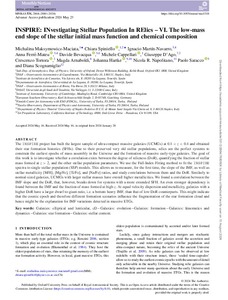INSPIRE: INvestigating Stellar Population In RElics - VI. The low-mass end slope of the stellar initial mass function and chemical composition
Maksymowicz-Maciata, Michalina; Spiniello, Chiara; Martín-Navarro, Ignacio; Ferré-Mateu, Anna; Bevacqua, Davide; Cappellari, Michele; D'Ago, Giuseppe; Tortora, Crescenzo; Arnaboldi, Magda; Hartke, Johanna; Napolitano, Nicola R.; Saracco, Paolo; Scognamiglio, Diana
https://urn.fi/URN:NBN:fi-fe2025082791802
Tiivistelmä
The INSPIRE project has built the largest sample of ultra-compact massive galaxies (UCMGs) at 0.1 < z < 0.4 and obtained their star formation histories (SFHs). Due to their preserved very old stellar populations, relics are the perfect systems to constrain the earliest epochs of mass assembly in the Universe and the formation of massive early-type galaxies. The goal of this work is to investigate whether a correlation exists between the degree of relicness (DoR), quantifying the fraction of stellar mass formed at z > 2, and the other stellar population parameters. We use the Full-Index-Fitting method to fit the INSPIRE spectra to single stellar population (SSP) models. This allows us to measure, for the first time, the slope of the IMF, as well as stellar metallicity [M/H], [Mg/Fe], [Ti/Fe], and [Na/Fe] ratios, and study correlations between them and the DoR. Similarly to normal-sized galaxies, UCMGs with larger stellar masses have overall higher metallicities. We found a correlation between the IMF slope and the DoR, that, however, breaks down for systems with a more extended SFH. An even stronger dependency is found between the IMF and the fraction of mass formed at high-z. At equal velocity dispersion and metallicity, galaxies with a higher DoR have a larger dwarf-to-giant ratio, i.e. a bottom heavy IMF, than that of low-DoR counterparts. This might indicate that the cosmic epoch and therefore different formation scenarios influence the fragmentation of the star formation cloud and hence might be the explanation for IMF variations detected in massive ETGs.
Kokoelmat
- Rinnakkaistallenteet [27094]
